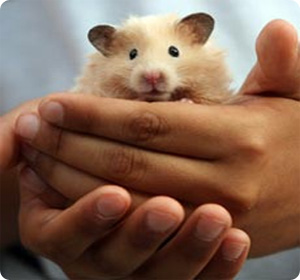HAMSTERS

General Information
The modern day pet hamster was first discovered in Syria in 1830. An Israeli Zoologist working in the Syrian desert brought the hamster back to his lab and was successful in breeding them. Later, in 1839 a British zoologist named George Waterhouse gave them their modern day name – the Golden Hamster. All common household pet hamsters are descendents of the Syrian desert hamsters.
Hamsters were shipped all over the world arriving in the United Kingdom in 1931 and later in the United States in 1938 for use in lab research. Hamsters are healthy, disease free animals and have the potential to have a new litter of babies nearly every month.
HAMSTER Scientific Information
Kingdom: Animalia
Phylum: Chordata
Class: Mammalia
Order: Rodentia
Suborder: Myomorpha
Superfamily: Muroidea
Family: Cricetidae
Subfamily: Cricetinae
HAMSTER Character Information
The Golden Hamster is a nocturnal animal, but occasionally will be active during the day. Pet hamsters can be very tame, but should always be handled with care – if frightened, they can become very aggressive. Although they are domesticated, hamsters are adept at chewing on and escaping from their cages. Once they escape they will not readily return to their home and must be trapped to be put back in their cage.
Hamsters enjoy exercise, especially wheel running. In fact, pregnant females have been known to run up to 5 miles per day!
Female hamsters are known to be more aggressive than males, and depending on her sexual cycle may attack new males that are introduced into her cage. Additionally, females will readily defend her young. If the mother feels threatened she will either attack the intruder or hide her babies in her mouth in her cheek pouches. Female hamsters with new litters should be disturbed as little as possible. | |
Other Categories
DOGS
CATS
HORSES
BIRDS
RABBITS
HAMSTERS
MICE AND RATS
GUINEA PIGS
FISH
|

